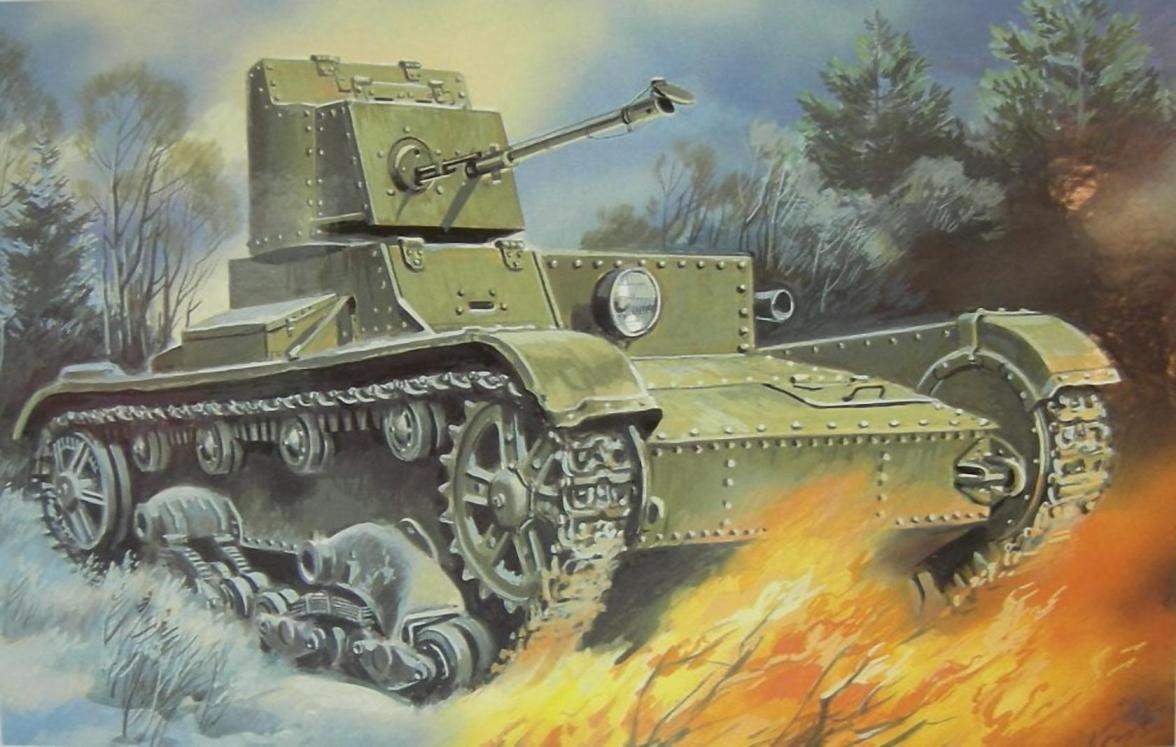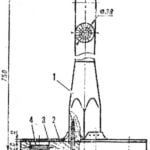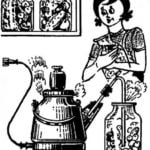 Light tank T-26 in the prewar years, became the most massive military armored vehicle of the red Army. Quite naturally the base of this tank was widely used by designers to create war machines for various purposes. The most massive non-linear modification of the “twenty-sixth” were chemical tanks which in total volume of production of the T-26 amounted to 12%. In the post-war literature, these combat vehicles were usually called flamethrower and the designation received abbreviation FROM (flamethrower tank): FROM-26, OT-130, OT-133, etc. In fact it is not so. These tanks were intended primarily for contamination, smoke and gametangia.
Light tank T-26 in the prewar years, became the most massive military armored vehicle of the red Army. Quite naturally the base of this tank was widely used by designers to create war machines for various purposes. The most massive non-linear modification of the “twenty-sixth” were chemical tanks which in total volume of production of the T-26 amounted to 12%. In the post-war literature, these combat vehicles were usually called flamethrower and the designation received abbreviation FROM (flamethrower tank): FROM-26, OT-130, OT-133, etc. In fact it is not so. These tanks were intended primarily for contamination, smoke and gametangia.
Therefore, the acronym in the pre-war documents are not found. They were called either HT (chemical tank), or bkhm (chemical warfare machine). Often used both designations. So, all chemical tanks based on the T-26 and KHT-26, KHT-130, etc. had oboznachenie BHM-3. In turn, the designation BHM-1 had a chemical car-based vehicles bkhm-2—on the basis of BT-5 (released in small numbers) and bkhm-4—based on the T-27 and T-37.
March 11, 1932, the revolutionary military Council of the USSR adopted a resolution “On granting the mechanized brigade chemical and other means to fight entrenched enemy infantry”. In accordance with this decree, the Military chemical Directorate of the red army were instructed “to develop a prototype chemical tank T-26, equipped it with a device smoke, the flamethrower and adapting to contamination by toxic substances”. The development of special equipment for chemical tank instructed the Bureau of the plant “Compressor”. In the summer of 1932 the first chemical sample tank based on the T-26, equipped with a flamethrower, pneumatic action, was admitted to the test.
Around the same time for mounting on linear tanks were created tank chemical device TKHP-3. It can be mounted on any machine without any alterations, was adopted for red army service and was produced at the plant “Compressor”. However, in the summer of 1934 TKHP-3 was intended only for “smoke and fire curtain” and received a code of TDP-3 (tank smoke device). By the end of 1936, the factory “Compressor” manufactured 1503 such a device.
With regard to the release function of toxic substances, it was found most expedient to give it a tank equipped with a flamethrower. In 1933 chemical warfare machine bkhm-3 (KHT-26) was adopted.
Chemical tank KHT-26 was created on the basis of a two-tower T-26 mod. 1931 Left tower was removed and in its place was a large hatch with hinged lid to access the flamethrower equipment KS-2. The apparatus consisted of a tank ognesmesi, toxic substances or smoke-forming mixture of 360 l, three of 13.5-liter compressed to 150 ATM. air, gasoline tank with a capacity of 0.7 liters and a system of hoses and valves.
In the turret of a tank mounted flamethrower and machine gun DT (1512 ammunition rounds). Range gametangia mixture of fuel oil and kerosene — 35 m. the Number of one-second shots—70. One shot under the pressure of the compressed air is 12 kg/cm2 was thrown out 5 years ognesmesi. The mixture was ignited from the torch of the burning of gasoline and gasoline—electric spark-plug. Rotation of the tower was restricted to a sector of 270° because of the danger of twisting of the flexible hose through which agneses were submitted to brancote.
Depending on combat tasks tank KHT-26, in addition to ognesmesi could be filled with smoke-forming mixture type S-III or S-IV, toxic substances persistent or unstable type, and also with water or soapy liquid for degassing areas. For spraying of the toxic substance and smoke was used atomizer, is located in the rear part of the vehicle.
From 1933 to 1936 was made 615 chemical tanks KHT-26.
Since 1938, was serially produced chemical tank KHT-130, designed on the basis of linear T-26 mod. 1933 the Tower was shifted relative to the longitudinal axis of the tank to the right. In the roof of the turret boxes to the left of the tower housed the inlets of reservoirs for ognesmesi. Fire equipment KS-25 installed in the fighting compartment, consisted of two tanks ognesmesi total capacity of 400 litres (filling capacity 360 l), four of 13.5-litre compressed air cylinders (150 ATM.) petrol tank ignition system with a capacity of 0.8 liters, hose and spark plugs. Range gametangia on the mixture of fuel oil and kerosene was 50 m. the Stock ognesmesi enough for 40 one-second shots. A single shot thrown 9 l ognesmesi. Working pressure in the tank when onemetre—18 ATM.

Chemical tank KHT-130:
1 —armored casing of the tip of the hose; 2—a box of ZIP; 3—nozzle system, smoke; 4—a fire extinguisher; 5—machine gun DT; 6—replacement spring; 7—caps filler necks of the tanks ognesmesi; 8—nadoennogo hatch cover; 9—air hood; 10—Luke the filler neck of the fuel tank; 11—hatch above the water necks and oil fuel tanks; 12—a reservation of sight TOP 1; 13—shield; 14—spare support roller; 15—Jack; 16—damper; 17 — tow chain; 18—hatch for access transmission; 19—the hatch to access the fan; 20—hatch for mounting of oil lines and filter; 21—hatches for access to the tubes of fuel tanks; 22—hatches for mounting the axes of the crank guide wheel; 23—the hatch to service the oil pump; 24—a hatch for access to the tube of the oil tank.
Agneses ignited from the torch of the burning of gasoline and gasoline — electric spark-plug. Automatic device for the ignition ognesmesi were located at the tip of the nozzle was protected by a shutter casing. Guidance of the hose at the target was carried out with the help of sight TOP 1. The hose of the flamethrower was located in the turret along with a coaxial machine gun DT. The maximum elevation angle of the twin installation was +10°, the angle pointing in the horizontal plane without rotation of the tower is 20°. Bringing a flamethrower and a machine gun DT (2898 ammunition cartridges) installed in the tower, were carried out using a shoulder rest. The difference between the tank HT-130, HT-26 was the possibility of doing gametangia 360°, since the inlet piping to the hose ognesmesi had a movable joint mounted at the bottom of the tank. Removal of hose remnants ognesmesi had a system to automatically purge after each shot with compressed air.
As with KHT-26, KHT tank-130 was equipped with smoke and start-up of toxic substances. The bandwidth of contamination at a speed of machine 12 km/h was 25 m, and the total area of infestation reached 20 000 m2. The maximum time smoke did not exceed 20 minutes. Width obscuration smoke screen was equal to 10 M.
The crew consisted of two people. Radio tank is not equipped with. Until the end of 1939, the industry has produced 324 tank KHT-130 (according to others—403 tank).
In 1939, the construction Bureau of factory No. 174 was designed and manufactured two prototypes of chemical tanks KHT-KHT 131 and-132. KHT-131 was a car with a flamethrower mounted in the turret right of the gun. Thus, the designers tried to combine artillery and flamethrower weapons. However, the placement in the tank gun, flamethrower, cylinders for the mixture and compressed air of the ammunition proved unsuccessful. The work of the crew in even more cramped car became almost impossible.
Using experience in KHT-131, factory No. 174 produced tank KHT-132, which arms refused. In the fall of 1939, after successful trials upgraded version of this machine have adopted under the symbol KHT-133.
Tank KHT-133 for installing the special equipment was identical to the tank KHT-130, but were created on the basis of the T-26 mod. 1939 the Only difference KHT-133 KHT-130 armament was the presence of the second gun DT in a ball mount in a niche of the tower. In fire equipment has made only minor changes: two gearbox was replaced with one more performance, set the foot down and changed the scheme of electrical equipment in the ignition system ognesmesi.
Chemical tank KHT-134 was created on the basis of the T-26 mod. 1939 in KB-2 of plant № 174, headed by engineer S. I. Slangman. Unlike previous combat vehicles of this assignment, the layout and armament of the base of the tank has remained unchanged. The flamethrower equipment was located in the fighting compartment and the compartment to the left of the driver. The capacity of the tanks with onesmas — 140 l, and one tank was located inside the hull and the other outside, on the rear turret boxes. The hose of the flamethrower was installed in a ball bearing to the left of the driver in the upper front plate. Range gametangia 50 m. per second it was possible to make 15 to 18 shots.

The layout of the tank KHT-130:
1—hose; 2—tanks for ognesmesi; 3—compressed air; 4—the pipeline to the flamethrower; 5—movable connection of pipelines; 6—an air collector; 7—nozzle system smoke; 8—valve dimonius
Conventionally not shown, the number of units chassis
When mounted flamethrower equipment with the base machine removed the small fuel tank, 60 rounds for 45-mm cannon and 15 drive to the machine gun DT. The crew consisted of three people.
In early 1940, the factory No. 174 produced two tanks KHT-134. Both cars entered the 210th chemical tank battalion and participated in the battles against the Finnish troops, during which one of them was hit.
Chemical tanks went into service mouth mechanized combat support and later tank brigades. 1935—adopted a separate chemical tank battalions. The latter, in turn, staffed the chemical tank brigades. By 1939, the red Army had three such teams — in the far East, the Volga region and in the Moscow military district.
Baptism of the chemical tanks of the red Army received in 1938 in the battles against the Japanese troops at O. Hassan, which were attended by 9 tanks KHT-26. In 1939, chemical tanks actively used in armed conflict at p. Halkin-Gol in Mongolia. To the beginning of the military operations of the 57th Special corps consisted of only 11 chemical tanks KHT-26 company-size combat support of the 11th armored brigade (two platoons of five tanks and tank company commander). Flamethrower mixtures there are three charging units and four in the warehouse. July 20, 1939 in the area of the fighting came the 2nd company of the chemical tanks of the 2nd Panzer chemical brigade. She had 18 KHT-130 flamethrower 10 charges of the mixture. However, it appeared that the staff of the company were very poorly prepared for onemetre. Therefore, prior to the company directly in the area of fighting with him a practical training in onemetre and studied combat experience already available at the tank-chemists of the 11th tank brigade. In addition, in the composition arrived at the front of the 6th tank brigade had 9 tanks KHT-26. By the beginning of August the troops of the 1st army group were 19 T-26 and 18 KHT-130.
Here it will be interesting to see with the assessment of the chemical tanks, the command after the completion of the operation to defeat the Japanese troops: “For the period August operation (20-29 August), all chemical tanks took part in combat. Especially actively they acted in the period 23 — 26 August, and in these days of KHT-130 went on the attack for 6-11 times.
During the period of conflict, chemical division spent 32 t flame mixture. Losses in men amounted to 19 people (9 dead and 10 wounded), the deadweight loss in the tanks and 12 vehicles, of which HT-26—10 (11 of them Panzer brigade—7 and the 6th tank brigade—3), HT-130—2.
The weak point of the use of flamethrower tanks was bad intelligence and preparation of machines to attack. The result was a large expenditure ognesmesi in the secondary areas and excessive losses.
During the first fights it was found that Japanese infantry can not withstand gametangia and afraid of the chemical tank. It showed the rout of the detachment Azuma on may 28-29, which was actively used by 5 KHT-26.

In subsequent battles, where used flamethrower tanks, the Japanese always leave their shelter, showing no resistance. For example, “July 12, a detachment of the Japanese in the composition of the reinforced company with 4 anti-tank guns penetrated deep into our location and that despite repeated attacks, offered stubborn resistance. Enter only one himank, which gave a jet of fire at the center of resistance caused in the ranks of the enemy panic, the Japanese from the front line trenches ran into the depths of the pit came to the rescue and our infantry occupied the ridge of the pit, this unit was finally destroyed.”
In the war with Finland, in addition to mouth combat support armored brigades, and was attended by five separate chemical tank battalions—201, 204, 210, 217 and 218—from the 30th and the 36th armored brigades. During the fighting chemical tanks proved very effective against the Finnish fortifications. However, they were more vulnerable than conventional tanks, and therefore suffered heavy losses. For example, in the “Report on the work of crews of Armored control on the Finnish front”, noted: “compared with the linear T-26 the percentage of failure of the chemical tanks is much higher.
According to reports, in parts with linear tanks percentage of combat losses is 14.9%, and in chemical tank battalion of 34.3%. The explanation for this is inevitable in case of fire when hit by debris in the tank agneses. If you have a large number ognesmesi fires chemical tanks continue for 15-20 hours and the temperature reaches such magnitude that the melt crankcases of engine and transmission, and even glass triplexes”.
The number of chemical tanks at the front steadily increased. So, if by 30 November in each of the five battalions and companies combat support armored brigades, there were 208 KHT-26 and KHT-130, in the war against plant. Voroshilov entered the army, and 168 new tanks (165 KHT-133, two KHT-134 and one KHT-130) and arrived from other military districts 70 KHT-26 and KHT-130. On the Karelian isthmus had 290 cars, and the rest were concentrated in the band of the 8th and 15th armies. Of the 446 chemical tanks involved in the fighting, lost 124 car, 24 of which — irretrievably. For maintenance of chemical tanks 18 January on the Karelian isthmus arrived and 302 repair-regenerative battalion. Until the end of the war it was repaired and evacuated 59 69 cars.
Despite the relatively high efficiency of chemical tanks, during the fighting, they have revealed the main drawback, inherent in all the tanks T-26—weakness of booking. But if the linear T-26 could fire at the enemy from long range, short range gametangia did not allow chemical tanks to hit targets at a distance of more than 50 m. of Course, they suffered heavy losses. Therefore, some KHT-133 received in the factory for additional shielding from 30-40-mm armor. During the Soviet-Finnish war were screened by 17 KHT-133.
Fighting 1939 -1940 helped to clarify the role of chemical tanks, tactics of their use and requirements. Gametangia became their main purpose. The use of flamethrower tanks in breaking the enemy’s defense was considered among other important matters of the top management team of the red army 23 — December 31, 1940. Reported to the commander of the Western special military district, Colonel-General of tank troops Pavlov and the commander of the 5th mechanized corps of the Transbaikal military district, Lieutenant-General M. F. Teryokhin. In the “Handbook for the fighter-tanker”, published in 1941 before the war, on the effects of flamethrower tanks mentioned briefly: “Gametangia applicable in any environment: advancing troops gametangia applied manpower in the open or in shelters, and enemy tanks, in the rear columns to ignite the warehouses and structures.”
In 1940, the red Army began the reform of the organizational structure of the armored forces. Chemical tank brigades were disbanded and their material part transferred to Panzer divisions newly created mechanized corps. The composition of each tank division has introduced two battalions of the chemical tanks for 54 cars, subordinated directly to the division commander. As of June 22, 1941, the mechanized corps of the red army, there were 994 chemical tank based on the T-26.
By the end of 1941, most of the chemical “twenty-sixth” was lost. However, a small number of them still used in battles on the southwestern, southern and Crimean fronts in the spring of 1942.
M. KNYAZEV



